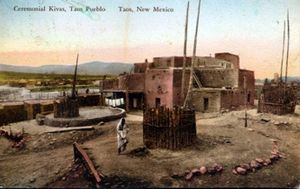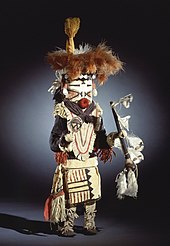Pueblo
| Pueblo | |
|---|---|
 | |
| Category | Federal UnitDistrict IV[1] |
| Created |
|
| Number | 19 in New Mexico[2]unknown amount in Arizona, Colorado, Utah or Mexico. 21 of them are federally recognized: 19 in New Mexico, 1 in Arizona, and 1 in Texas |
| Government | |
Pueblorefers to the settlements and to theNative American tribesof thePueblo peoplesin theSouthwestern United States,currently inNew Mexico,Arizona,andTexas.The permanent communities, including some of the oldest continually occupied settlements in the United States, are called pueblos (lowercased).
Spanish explorers of northernNew Spainused the termpuebloto refer to permanent Indigenous towns they found in the region, mainly inNew Mexicoand parts ofArizona,in the former province ofNuevo México.This term continued to be used to describe the communities housed in apartment structures built of stone,adobe,and other local material.[3]The structures were usually multi-storied buildings surrounding an open plaza, with rooms accessible only through ladders raised and lowered by the inhabitants, thus protecting them from break-ins and unwanted guests. Larger pueblos were occupied by hundreds to thousands ofPuebloanpeople.
Severalfederally recognized tribeshave traditionally resided in pueblos of such design. LaterPueblo Decoand modernPueblo Revival architecture,which mixes elements of traditional Pueblo andHispanodesign, has continued to be a popular architectural style inNew Mexico.
The term is now part of the proper name of some historical sites, such asPueblo of Acoma.
Etymology and usage[edit]
| This article is part ofa serieson |
| Political divisions of the United States |
|---|
 |
| First level |
|
|
| Second level |
|
|
| Third level |
|
|
| Fourth level |
| Other areas |
|
|
|
United States portal |
The wordpueblois the Spanish word both for "town" or "village" and for "people". It comes from the Latin root wordpopulusmeaning "people". Spanish colonials applied the term to their own civic settlements, but to only those Native American settlements having fixed locations and permanent buildings.[4]
In theRio Grande Valleyof New Mexico, specifically in the region between Albuquerque, Santa Fe and Taos, the word "pueblo" defines a "distinct cultural group in the Southwestern United States" and their villages. The Holmes Museum of Anthropology defines this specific group as a "common culture with individual variances [that] connects them.[5]
Less-permanent native settlements (such as those found in California) were often referred to asrancherías,[6]however, the oldest area ofLos Angeleswas known asEl Pueblo de Nuestra Señorala Reina de los Ángeles del Rio de PorciúnculaorEl Pueblo de Los Angelesfor short.[7][8]
On the central SpanishMesetathe unit of settlement was and is thepueblo;which is to say, the largenucleated villagesurrounded by its own fields, with no outlying farms, separated from its neighbors by some considerable distance, sometimes as much as ten miles [16 km] or so. The demands of agrarian routine and the need for defense, the simple desire for human society in the vast solitude of, dictated that it should be so. Nowadays the pueblo might have a population running into thousands. Doubtless, they were much smaller in the earlymiddle ages,but we should probably not be far wrong if we think of them as having had populations of some hundreds.[4]
Pueblo tribes[edit]
Of the federally recognized Native American communities in the Southwest, those designated by theKing of Spainas pueblo at the time Spainceded territoryto the United States, after the American Revolutionary War, are legally recognized as Pueblo by theBureau of Indian Affairs.Some of the pueblos also came under the jurisdiction of the United States, in its view, by its treaty withMexico,which had briefly gained rule over territory in the Southwest ceded by Spain after Mexican independence. There are 21 federally recognized Pueblos[9]that are home toPueblo peoples.Their official federal names are as follows:
- Hopi Tribe of Arizona(Uto-Aztecan)
- Ohkay Owingeh,New Mexico (Kiowa-Tanoan)
- Pueblo of Acoma,New Mexico(Keresan)
- Pueblo of Cochiti,New Mexico (Keresan)
- Pueblo of Isleta,New Mexico (Kiowa-Tanoan)
- Pueblo of Jemez,New Mexico (Kiowa-Tanoan)
- Pueblo of Laguna,New Mexico (Keresan)
- Pueblo of Nambe,New Mexico (Kiowa-Tanoan)
- Pueblo of Picuris,New Mexico (Kiowa-Tanoan)
- Pueblo of Pojoaque,New Mexico (Kiowa-Tanoan)
- Pueblo of San Felipe,New Mexico (Keresan)
- Pueblo of San Ildefonso,New Mexico (Kiowa-Tanoan)
- Pueblo of Sandia,New Mexico (Kiowa-Tanoan)
- Pueblo of Santa Ana,New Mexico (Keresan)
- Pueblo of Santa Clara,New Mexico (Kiowa-Tanoan)
- Pueblo of Taos,New Mexico (Kiowa-Tanoan)
- Pueblo of Tesuque,New Mexico (Kiowa-Tanoan)
- Pueblo of Zia,New Mexico (Keresan)
- Santo Domingo Pueblo(alsoKewa Pueblo), New Mexico (Keresan)
- Ysleta Del Sur Pueblo,Texas (Kiowa-Tanoan)
- Zuni Tribe of the Zuni Reservation,New Mexico (Zuni)[10]
Oneunrecognized tribe,thePiro/Manso/Tiwa Indian Tribe of the Pueblo of San Juan Guadalupeis currently petitioning the US Department of the Interior for federal recognition.[11]
Civic institutions[edit]

Each Pueblo is autonomous with its own governmental structure. Several organizations serve to unite the interests of difference Pueblos including the Albuquerque-basedAll Pueblo Council of Governors[12]who collectively negotiates for land and water rights and advocates for Pueblo interests with the state and federal government. The interests ofEight Northern Pueblosare served by the Eight Northern Indian Pueblos Council based in Ohkay Owingeh (formerly San Juan Pueblo).[12]Cochiti, Jemez, Sandia, Santa Ana, and Zia are served by the Five Sandoval Indian Pueblos, a nonprofit organization based in Rio Rancho.[12]
TheIndian Pueblo Cultural Center,founded in 1976 in Albuquerque, educates the public about all Pueblos through art, dance, and educational experiences.[13]The center has a museum that presents Pueblo history and artifacts, and an interactive Pueblo House museum. An archive holds a collection of photographs, books, and tape recordings of oral histories.[14]It also has a café and a restaurant,[13]Indian Pueblo Kitchen, servingIndigenous cuisine.[15]
Historical places[edit]

Pre-Columbiantowns and villages in the Southwest, such asAcoma,were located in defensible positions, for example, on high steepmesas.Anthropologistsand official documents often refer to ancient residents of the area as pueblo cultures. For example, theNational Park Servicestates, "The Late Puebloan cultures built the large, integrated villages found by the Spaniards when they began to move into the area."[16] The people of some pueblos, such asTaos Pueblo,still inhabit centuries-old adobe pueblo buildings.[17]
Contemporary residents often maintain other homes outside the historic pueblos.[17]Adobe and light construction methods resembling adobe now dominate architecture at the many pueblos of the area, in nearby towns or cities, and in much of theAmerican Southwest.[18]
In addition to contemporary pueblos, numerousruinsofarcheologicalinterest are located throughout the Southwest. Some are of relatively recent origin. Others are of prehistoric origin, such as thecliff dwellingsand otherhabitationsof theAncestral Puebloans,who emerged as a people around the 12th century BCE and began to construct their pueblos about 750–900 CE.[19][20]
Feast days[edit]
Many pueblos participate insyncretismbetween Indigenous Pueblo religion and Roman Catholicism. The pueblos welcome outsiders to participate in feast days, in which the Pueblo communities hold seasonal ceremonial dances, and certain households volunteer to feed visitors meals. Photography is forbidden.[21]Visitors are advised to confirm events in advance with the Pueblos.[22]
Dances include the antelope, bow-and-arrow, Comanche, corn, basket, buffalo, deer, harvest,Matachines,and turtle dances.[21][22]
- January
- 1: Transer of Canes: dances at most pueblos[21][22]
- 6: King's Day Celebration: Nambé, Picuris, Sandia, Santa Ana,[22]Santo Domingo, Taos[21]
- 22–23: feast: San Ildefonso[21][22]
- 25: Picuris, San Ildefonso[21]
- February
- 1st or 2nd weekend: Governor's Feast: Old Acoma, Ohkay Owingeh[21][22]
- 2nd weekend:Caldelaria Day:Picuris,[22]San Felipe[21]
- March
- 19:St. Josephfeast: Laguna[21][22]
- April
- Easter weekend: most pueblos[21][22]
- Easter Sunday: Jemez,[22]Nambé, Santo Domingo, San Ildefonso, Zia[21]
- May
- May 1:St. PhilipFeast: San Felipe[21][22]
- May 3:Feast of the Cross:Taos[21]
- First Sunday:Santa MariaFeast: Acoma[21][22]
- June
- First Sunday of the month: Blessing of the fields: Tesuque[21]
- 13:San Antoniofeast: Ohkay Owingeh, Picuris, Sandia, Santa Clara, Taos[21][22]
- 13: Ysleta del Sur[citation needed]
- 24:St John the Baptistfeast: Ohkay Owingeh, Taos[22]
- 29:San Pedro/St. Paulfeast: Santa Ana, Santo Domingo[21][22]
- July
- 14:St. Bonaventurefeast: Cochiti[21][22]
- 25:Santiagofeast: Taos[21][22]
- 26:St. Annefeast: Laguna, Santa Ana, Taos[21][22]
- 28: Peoples' Day: Pojoaque, Santa Ana[22]
- August
- 2:San Persingulafeast: Jemez[21][22]
- 4:Santo Domingofeast: Santo Domingo[21][22]
- 9:San Lorenzofeast: Picuris[21][22]
- 10:Pueblo Revoltanniversary andSan Lorenzofeast: Acoma, Picuris[21][22]
- 12:Santa Clarafeast: Santa Clara[21][22]
- 15:Assumption of Our Blessed Motherfeast: Laguna, Zia[21][22]
- 28:San Augustinefeast: Isleta[21][22]
- September
- 2:San Estevanfeast: Acoma[21][22]
- 4:San Augustinefeast: Isleta[21]
- 8:Nativity of the Blessed Virginfeast: Laguna,[22]San Ildefonso[21]
- 14: Ohkay Owingeh Pueblo[21]
- 19:St. Josephfeast: Laguna[21][22]
- 25:St. Elizabethfeast: Laguna[21][22]
- 29:San Geronimo Evefeast: Taos[21]
- 30:San Geronimofeast: Taos[21][22]
- October
- 4:St. Francis of Assisifeast: Nambé[21][22]
- 17:St. Margaret Maryfeast: Laguna[21][22]
- 24–27: Laguna[21]
- November
- 12:San Diegofeast: Jemez, Tesuque[21][22]
- Thanksgiving Weekend: Acoma[21]
- Thanksgiving Day: Christmas light parade: Zuni[21][22]
- December
- 11:Nuestra Senora de Guadalupefeast: Pojoaque[21][22]
- 12:Our Lady of Guadalupefeast: Jemez, Pojoaque,[22]Santa Clara, Tesuque[21]
- 24: Christmas Eve celebration: Acoma, Laguna Nambé, Ohkay Owingeh, Picuris, San Felipe, Santa Ana, Taos, Tesuque[21][22]
- 25: Christmas Day: Cochiti, Ohkay Owingeh, Picuris, Santo Domingo, San Ildefonso, Tesuque, Zia[21][22]
- 25–27: Cochiti, Laguna[21][22]
- 26: Ohkay Owingeh[21][22]
- 26–28: Christmas dances at most pueblos[21][22]
- 28:Holy Innocents Day:Ohkay Owingeh, Picuris[21][22]
See also[edit]
- All Pueblo Council of Governors
- Ancestral Puebloan dwellings
- Ancestral Puebloans
- Pueblo Revolt
- Pueblo music
- Pueblo architecture
- Pueblo pottery
- Pueblo Lands Act
References[edit]
- ^"District IV".Bureau of Indian Affairs.U.S. Department of the Interior.Retrieved9 March2024.
- ^"23 NM Federally Recognized Tribes in NM Counties".Secretary of State of New Mexico.Retrieved20 February2022.
- ^Stewart, George(2008) [1945].Names on the Land: A Historical Account of Place-Naming in the United States.New York: NYRB Classics. pp. 23–24.ISBN978-1-59017-273-5.
- ^abFletcher, Richard A. (1984)Saint James's Catapult: The Life and Times of Diego Gelmírez of Santiago de Compostela,Oxford: Oxford University Press,ISBN0-19-822581-4(on-line text, ch. 1)
- ^"About the pueblos".Morgan Museum of Anthropology, Collection of Southwest Pottery.Retrieved15 March2024.
- ^Rancheria.Archived2005-01-11 at theWayback MachineThe Columbia Encyclopedia, Sixth Edition.2001-07 (retrieved 12 April 2009)
- ^"Origin of the Name Los Angeles".laalmanac.Retrieved9 March2023.
- ^Pool, Bob (26 March 2005)."City of Angel's First Name Still bedevils historians".The Los Angeles Times.Retrieved9 March2024.
- ^"Indian Entities Recognized and Eligible To Receive Services From the United States Bureau of Indian Affairs; Notice"Federal Register12 July 2002, Part IV, Department of Interior, Bureau of Indian Affairs
- ^Indian Affairs Bureau (8 January 2024)."Indian Entities Recognized by and Eligible To Receive Services From the United States Bureau of Indian Affairs".Federal Register.89(944): 944–48.Retrieved8 March2024.
- ^"Petition #005: Piro/Manso/Tiwa Indian Tribe of the Pueblo of San Juan de Guadalupe, NM".Indian Affairs.U.S. Department of the Interior, Indian Affairs. 29 September 2015.Retrieved9 March2024.
- ^abc"New Mexico Pueblos: Pueblo Organizations".New Mexico Department of Indian Affairs.Retrieved9 March2024.
- ^ab"Indian Pueblo Cultural Center".New Mexico True.Retrieved9 March2024.
- ^McCullah, Tazbah (Winter 2007)."Indian Pueblo Cultural Center, Albuquerque, New Mexico".Journal of the West.46(a): 30–31.Retrieved10 March2024.
- ^"Indian Pueblo Kitchen".Indian Pueblo Cultural Center.Retrieved10 March2024.
- ^NPS with link to PDF file: "The Origins of the Salinas Pueblos",inIn the Midst of a Loneliness: The Architectural History of the Salinas Missions,U.S. National Park Service
- ^abGibson, Daniel (2001)Pueblos of the Rio Grande: A Visitor's Guide,Rio Nuevo Publishers, Tucson, Arizona, p. 78,ISBN1-887896-26-0
- ^Paradis, Thomas W. (2003)Pueblo Revival ArchitectureArchived2008-02-10 at theWayback Machine,Northern Arizona University
- ^Hewit "Puebloan History"Archived2016-10-21 at theWayback Machine,University of Northern Colorado
- ^Gibson, Daniel (2001) "Pueblo History", inPueblos of the Rio Grande: A Visitor's Guide,Tucson, Arizona: Rio Nuevo Publishers, pp. 3–4,ISBN1-887896-26-0
- ^abcdefghijklmnopqrstuvwxyzaaabacadaeafagahaiajakalamanaoapaqarasatauavaw"Calendar of Pueblo Feast Days & Other Events at the Pueblos".Santa Fe Selection Travel Guide.Retrieved18 March2024.
- ^abcdefghijklmnopqrstuvwxyzaaabacadaeafagahaiajakalamanaoapaq"Feast Days".Indian Pueblo Cultural Center.Retrieved18 March2024.
External links[edit]
- TheSMU-in-Taos Research Publicationscollection contains nine anthropological and archaeological monographs and edited volumes representing decades of research, primarily on Pueblo Indian sites near Taos, New Mexico, includingPapers on Taos archaeology,Taos Archeology,Picuris Pueblo through time: eight centuries of change in a northern Rio Grande puebloandExcavations at Pot Creek Pueblo.
